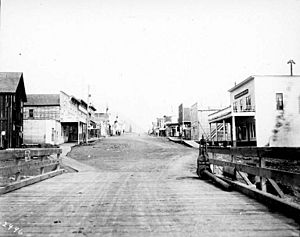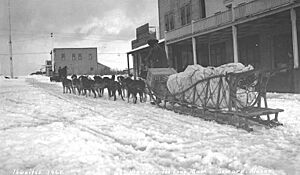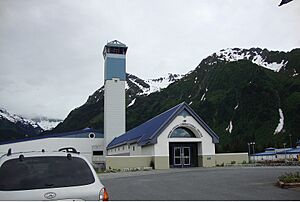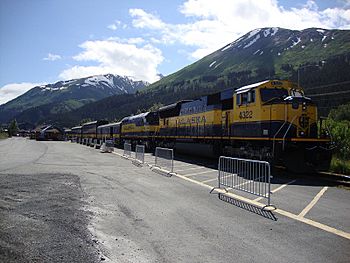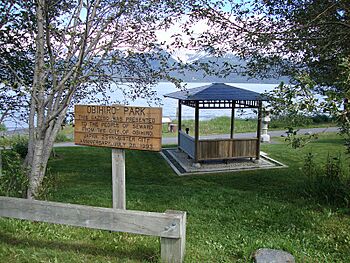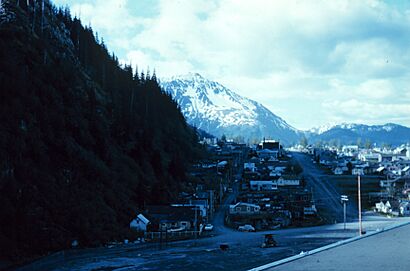Seward, Alaska facts for kids
Quick facts for kids
Seward
Qutalleq
|
|||
|---|---|---|---|
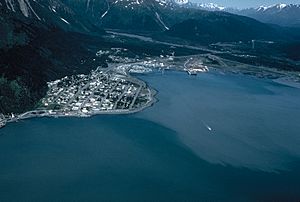
Aerial view of Seward
|
|||
|
|||
| Nickname(s):
"Gateway to the Kenai Fjords"
|
|||
| Motto(s):
"Alaska Starts Here"
|
|||

Location in Kenai Peninsula Borough, Alaska
|
|||
| Country | United States | ||
| State | Alaska | ||
| Borough | Kenai Peninsula | ||
| Established | 1903 | ||
| Incorporated | June 1, 1912 | ||
| Government | |||
| • Type | Council-manager | ||
| Area | |||
| • Total | 21.89 sq mi (56.69 km2) | ||
| • Land | 13.96 sq mi (36.16 km2) | ||
| • Water | 7.93 sq mi (20.54 km2) | ||
| Elevation | 0 ft (0 m) | ||
| Population
(2020)
|
|||
| • Total | 2,717 | ||
| • Density | 194.63/sq mi (75.15/km2) | ||
| Time zone | UTC−9 (Alaska) | ||
| • Summer (DST) | UTC−8 (Alaska) | ||
| ZIP code |
99664
|
||
| Area code | 907 | ||
| FIPS code | 02-68560 | ||
| GNIS feature ID | 1414598 | ||
| Source of coordinates | |||
Seward is a city in Alaska, United States. It is located on Resurrection Bay, which is a type of narrow ocean inlet called a fjord. Seward sits on Alaska's southern coast, about 120 miles (193 km) by road from Anchorage, Alaska's largest city.
As of the 2020 census, Seward had 2,717 people. It is the fourth-largest city in the Kenai Peninsula Borough. The city is named after William H. Seward, who was a United States Secretary of State. He helped the United States buy Alaska from the Russian Empire in 1867.
Seward is the southern end of the Alaska Railroad. It is also the historic starting point of the original Iditarod Trail, which leads into the middle of Alaska. Mile 0 of this trail is marked on the shoreline at the south end of town.
Contents
Seward's History
In 1793, Alexander Baranov set up a fur trade post on Resurrection Bay, where Seward is today. A three-masted ship called the Phoenix was built there by an English shipbuilder working for the Russians.
Seward became an important port during World War II for military activities in Alaska. Fort Raymond was built near Seward to protect the area. An Army airfield was also built, which later became Walseth Air Force Base. Both of these military sites closed soon after the war ended.
A large part of Seward was damaged by strong shaking and a local tsunami during the 1964 Alaska earthquake.

The city of Seward covers about 21.5 square miles (55.7 square kilometers). About 14.4 square miles (37.3 square kilometers) is land, and 7.1 square miles (18.4 square kilometers) is water.
Seward is bordered by the lower part of the Resurrection River to the north. To the south, the city limits reach the community of Lowell Point. On the east and west, the city is surrounded by Resurrection Bay and the steep slopes of Mount Marathon.
Other nearby communities include Lowell Point to the south, and Bear Creek and Moose Pass further north. The closest incorporated city is Soldotna, which is about 90 miles (145 km) away by road.
Weather in Seward
Seward has a mild climate for Alaska because of the nearby Gulf of Alaska. Temperatures are not as extreme as in other parts of the state. Only January has an average daily high temperature below freezing. Temperatures below zero degrees Fahrenheit are very rare.
The ocean also brings a lot of rain and snow to Seward. The most precipitation happens during the fall and winter months.
| Climate data for Seward, Alaska (Seward Airport), 1991–2020 normals, extremes 1997–present | |||||||||||||
|---|---|---|---|---|---|---|---|---|---|---|---|---|---|
| Month | Jan | Feb | Mar | Apr | May | Jun | Jul | Aug | Sep | Oct | Nov | Dec | Year |
| Record high °F (°C) | 61 (16) |
50 (10) |
57 (14) |
74 (23) |
80 (27) |
88 (31) |
87 (31) |
86 (30) |
76 (24) |
62 (17) |
54 (12) |
52 (11) |
88 (31) |
| Mean maximum °F (°C) | 44.6 (7.0) |
44.5 (6.9) |
47.7 (8.7) |
56.3 (13.5) |
69.3 (20.7) |
74.0 (23.3) |
78.1 (25.6) |
73.6 (23.1) |
67.7 (19.8) |
55.6 (13.1) |
47.0 (8.3) |
44.8 (7.1) |
79.9 (26.6) |
| Mean daily maximum °F (°C) | 31.3 (−0.4) |
34.3 (1.3) |
37.3 (2.9) |
45.4 (7.4) |
53.4 (11.9) |
59.0 (15.0) |
62.2 (16.8) |
62.0 (16.7) |
55.7 (13.2) |
45.7 (7.6) |
36.1 (2.3) |
33.2 (0.7) |
46.3 (8.0) |
| Daily mean °F (°C) | 26.2 (−3.2) |
28.9 (−1.7) |
31.1 (−0.5) |
38.8 (3.8) |
46.3 (7.9) |
52.3 (11.3) |
56.2 (13.4) |
55.8 (13.2) |
49.6 (9.8) |
40.2 (4.6) |
31.4 (−0.3) |
28.2 (−2.1) |
40.4 (4.7) |
| Mean daily minimum °F (°C) | 21.1 (−6.1) |
23.5 (−4.7) |
24.9 (−3.9) |
32.2 (0.1) |
39.2 (4.0) |
45.7 (7.6) |
50.2 (10.1) |
49.6 (9.8) |
43.4 (6.3) |
34.7 (1.5) |
26.6 (−3.0) |
23.2 (−4.9) |
34.5 (1.4) |
| Mean minimum °F (°C) | 4.7 (−15.2) |
8.1 (−13.3) |
11.7 (−11.3) |
21.8 (−5.7) |
31.2 (−0.4) |
37.7 (3.2) |
43.3 (6.3) |
42.7 (5.9) |
34.9 (1.6) |
25.7 (−3.5) |
14.5 (−9.7) |
9.1 (−12.7) |
1.6 (−16.9) |
| Record low °F (°C) | −6 (−21) |
−15 (−26) |
2 (−17) |
10 (−12) |
28 (−2) |
35 (2) |
39 (4) |
38 (3) |
29 (−2) |
15 (−9) |
5 (−15) |
−1 (−18) |
−15 (−26) |
| Average precipitation inches (mm) | 6.47 (164) |
6.35 (161) |
3.85 (98) |
4.29 (109) |
3.50 (89) |
2.34 (59) |
3.11 (79) |
5.39 (137) |
9.90 (251) |
8.69 (221) |
7.60 (193) |
8.22 (209) |
69.71 (1,770) |
| Average snowfall inches (cm) | 12.9 (33) |
12.6 (32) |
10.5 (27) |
3.7 (9.4) |
0.3 (0.76) |
0.0 (0.0) |
0.0 (0.0) |
0.0 (0.0) |
0.0 (0.0) |
0.5 (1.3) |
8.2 (21) |
15.7 (40) |
64.4 (164.46) |
| Average precipitation days (≥ 0.01 in) | 13.6 | 13.8 | 12.4 | 14.2 | 13.5 | 11.1 | 13.4 | 15.2 | 17.1 | 16.6 | 14.0 | 15.9 | 170.8 |
| Average snowy days (≥ 0.1 in) | 5.8 | 5.0 | 4.7 | 2.2 | 0.1 | 0.0 | 0.0 | 0.0 | 0.0 | 0.8 | 3.9 | 6.7 | 29.2 |
| Source 1: NOAA (average snowfall/snow days 1981–2010) | |||||||||||||
| Source 2: National Weather Service | |||||||||||||
Seward's Economy
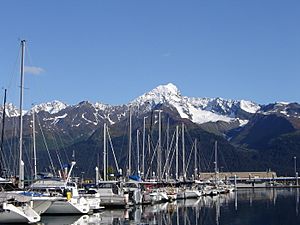
Seward's economy mainly relies on commercial fishing and tourism. Many hotels, restaurants, and shops in the city are open only during the summer tourist season. This season usually runs from mid-May to mid-September.
Other big employers in Seward include the Spring Creek Correctional Center (a state prison), the AVTEC vocational school, and the local Providence Health & Services hospital.
Fishing Industry
Seward is a very important port for commercial fishing in the United States. In 2016, fishing boats in Seward brought in about 13,500 tons of fish and shellfish. This catch was worth about $42 million. Over ten years, from 2007 to 2016, about $545 million worth of seafood passed through Seward's harbor.
Tourism and Visitors
Seward is a popular spot for tourists visiting Alaska. It is the southern end of the Alaska Railroad and has good roads connecting it to Anchorage. Many large cruise ships use Seward as a northern port for their Alaskan trips.
Seward is also known as the "gateway community" for Kenai Fjords National Park. This means it's a main entry point for visitors to the park.
Population and People
| Historical population | |||
|---|---|---|---|
| Census | Pop. | %± | |
| 1910 | 534 | — | |
| 1920 | 652 | 22.1% | |
| 1930 | 835 | 28.1% | |
| 1940 | 949 | 13.7% | |
| 1950 | 2,114 | 122.8% | |
| 1960 | 1,891 | −10.5% | |
| 1970 | 1,587 | −16.1% | |
| 1980 | 1,843 | 16.1% | |
| 1990 | 2,699 | 46.4% | |
| 2000 | 2,830 | 4.9% | |
| 2010 | 2,693 | −4.8% | |
| 2020 | 2,717 | 0.9% | |
| U.S. Decennial Census | |||
Seward first appeared in the U.S. Census in 1910. It officially became a city in 1912.
In 2000, there were 2,830 people living in Seward. About 72% of the people were White, and about 17% were Native American. About 2% of the population was Hispanic or Latino.
The average age of people in Seward in 2000 was 37 years old. About 22% of the population was under 18 years old.
City Government and Services
Seward has a council–manager style of government. This means citizens elect a seven-member city council. The council then hires a city manager, city attorney, and city clerk. These people are in charge of local services like police, fire, utilities, and managing the harbor.
The United States Postal Service has a post office in Seward.
Education in Seward
The Kenai Peninsula Borough School District runs the schools in Seward. These include Seward Elementary School, Seward Middle School, and Seward High School.
Getting Around Seward
Seward is special because it has road access to Anchorage via the Seward Highway. This highway is a National Scenic Byway. Bus services also use this road.
Seward is the southern end of the Alaska Railroad. The railroad serves the Port of Seward, which can handle large ocean ships. This keeps the port busy with cargo coming on and off trains. It also makes Seward a main stopping point for cruise ships heading north. Cruise ship passengers often take the train or bus further north to Anchorage or Denali. The Alaska Railroad offers passenger service to Seward during certain seasons with its Coastal Classic train. In 2023, nearly 200,000 tourists visited Seward on 87 cruise ship visits.
The Alaska Railroad Corporation is building a new cruise ship dock and terminal in Seward. This project is expected to open in 2026.
Seward is also a very bike-friendly city. There is a paved bike path that runs along the waterfront, through the harbor, and along the highway. You can rent bikes and take guided bike tours in the area.
Ferry service from the Alaska Marine Highway stopped in Seward at the end of 2005. Now, state ferry connections are available in Whittier (90 miles north) or Homer (150 miles by highway).
Seward Airport (PAWD/SWD) is used for small planes and flight-seeing tours. You can find scheduled commercial flights at Kenai Municipal Airport in Kenai and Ted Stevens Anchorage International Airport. Both are about 100 miles (161 km) away. Bus connections are also available to these airports.
Sister Cities
Seward has special connections with cities in other countries:
- Obihiro, Hokkaido, Japan (since 1968)
- Kushiro, Hokkaido, Japan (since 1982)
- Yeosu, South Korea (an informal connection)
Famous People from Seward
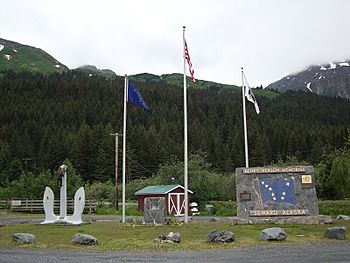
- Benny Benson (1913–1972): An Alaska Native who designed the Alaskan state flag.
- Lydia Jacoby (born 2004): A swimmer who won a gold medal at the 2020 Summer Olympics. She was the first Alaskan to compete in swimming at the Olympics.
- Harry Kawabe (1890–1969): A Japanese-American businessman.
Fun Things to Do in Seward
- Climb Mount Marathon and watch or join the famous Mount Marathon Race.
- Visit Kenai Fjords National Park and its easy-to-reach Exit Glacier.
- Explore the Alaska SeaLife Center, a public aquarium and research center.
- Join the Seward Silver Salmon Derby, a popular fishing event.
- Take part in the Seward Polar Bear Jump-Off, a chilly winter event.
- Enjoy the Seward Spring Break Up Festival.
- Attend the Seward Music and Arts Festival every September.
- Check out the Balto Film Fest, held the last weekend of July.
- See the ruins of the Jesse Lee Home for Children.
- Go on boat tours to Holgate Glacier in Kenai Fjords National Park.
- Seward is known as "The Fat Bike Capital of the World" because it has many fat-bike owners.
See also
 In Spanish: Seward (Alaska) para niños
In Spanish: Seward (Alaska) para niños




